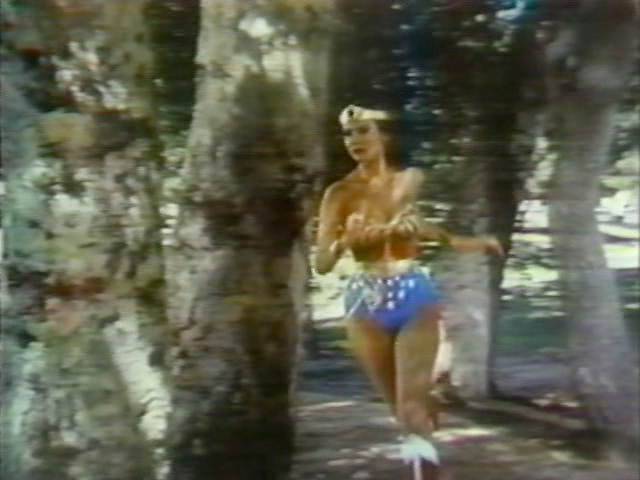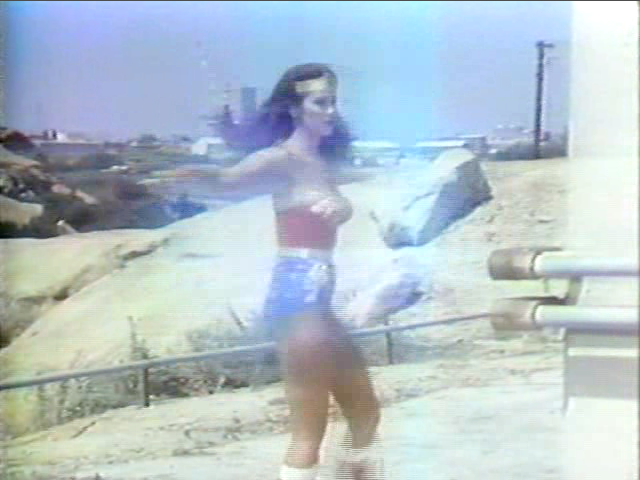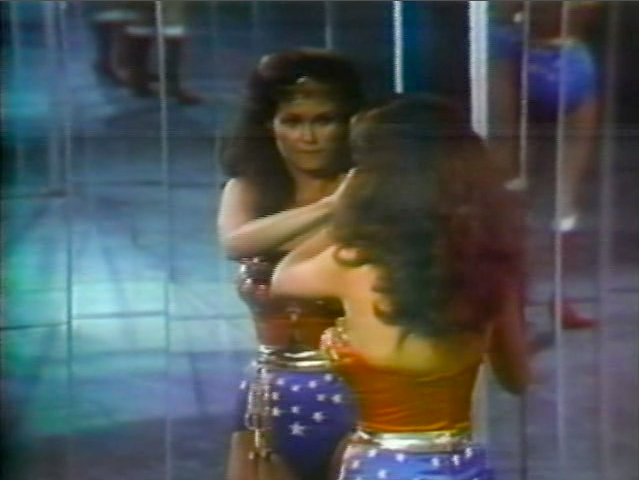Dara Birnbaum - Technology/Transformation: Wonder Woman (1978)
Tuesday, January 29, 2008
Download this via KaraGarga.
Dara Birnbaum is an American video artist who is perhaps most famous for her provocative and influential contributions to the contemporary discourse on art and popular culture. Through video works and multi media installations, Birnbaum subverts, critiques and deconstructs hegemony of mass media images and gestures to confront the mythologies of culture and history. If we define appropriation as an act that takes possession of another’s imagery or idea, often without permission, then Dara Birnbaum fits the bill.
[Technology/Transformation: Wonder Woman, 1978-79, video, Electronic Arts Intermix, NY.]
In her video Technology/Transformation: Wonder Woman, Dara Birnbaum created one of the first examples of appropriation imagery from mainstream television, something that is now quite common. Technology/Transformation: Wonder Woman, features, as one might expect, Wonder Woman, the main character of the prime-time television programm of the same name which was based on an action-adventure comic book. Using actual sceans from the series, Birnbaum “plung[es] the viewer headlong into the ver experience of TV- unveiling TV’s steriotypical gestures of power and submission, of male and female egos.” -
Birnbaum isolates and repeats the moments of the ‘real’ womans transformation into superhero. In doing so, Birnabaum is subverting its meaning within the television context. She is also appropriating televison filming conventions to deconstruct the idiomatic meaning of televisions structural codes, she uses these to anayze the syntax and gestures of what Birnbaum calls “TV treatmeant”.
Explosive bursts of fire open Technology/Transformation, an incendiary deconstruction of the ideology embedded in television form and pop cultural iconography. Appropriating imagery from the TV series Wonder Woman, Birnbaum isolates and repeats the moment of the "real" woman's symbolic transformation into super-hero. Entrapped in her magical metamorphosis by Birnbaum's stuttering edits, Wonder Woman spins dizzily like a music-box doll. Through radical manipulation of this female Pop icon, she subverts its meaning within the television text. Arresting the flow of images through fragmentation and repetition, Birnbaum condenses the comic-book narrative -- Wonder Woman deflects bullets off her bracelets, "cuts" her throat in a hall of mirrors -- distilling its essence to allow the subtext to emerge. In a further textual deconstruction, she spells out the words to the song Wonder Woman in Discoland on the screen. The lyrics' double entendres ("Get us out from under ... Wonder Woman") reveal the sexual source of the superwoman's supposed empowerment: "Shake thy Wonder Maker." Writing about the "stutter-step progression of `extended moments' of transformation from Wonder Woman," Birnbaum states, "The abbreviated narrative -- running, spinning, saving a man -- allows the underlying theme to surface: psychological transformation versus television product. Real becomes Wonder in order to "do good" (be moral) in an (a) or (im)moral society."
Technical Assistance: Ed Slopek/Nova Scotia College of Art and Design. Original Television Footage: CBS Inc. "Wonder Woman." Sound: The Wonderland Disco Band.




Buchloh, Benjamin. "Dara Birnbaum: Allegorical Procedures." Medij v mediju/Media in Media Ljubljana, Slovenia: 1996. pp. 46-55 + 149,150
Dara Birnbaum. Kunsthalle Wien, Vienna: Verlag Ritter Klagenfurt, 1995.
Detterer, Gabriele. Art Recollection, Artists' Interviews and Statements in the Nineties. Florence: Danilo Montanari & Exit & Zona Archives Editori, 1997.
Ross, David. "Truth or Consequences: American Television and Video Art." Video Culture: A Critical Investigation. Ed. John Hanhardt, Rochester: Studies Workshop Press, 1986. pp. 169-170, 174-178.
Seeing Time: Selections from the Pamela and Richard Kramlich Collection of Media Art. San Francisco: San Francisco Museum of Modern Art, 1999.
"The First Decade: Video From the EAI Archives" at the Museum of Modern Art
by Ed Halter
Village Voice
February 20 - 26, 2002
It's hard to even envision a world without Blockbuster and camcorders, 100 channels of cable TV, Jumbotron billboards, digital cinema, or streaming media—a world before the distracting array of mesmerizing tech developed during the last two decades of hyperactive consumer culture. Prior to the '80s, video wasn't rare, exactly, but its only visible manifestation was the wood-paneled monolith of broadcast television. Art history apocrypha claims that the first challenge to TV's cultural monopoly appeared at the moment of Nam June Paik's purchase of a Portapak in 1965. Entranced by the novelty of artist-made television and the futuristic exhortations of Marshall McLuhan and Buckminster Fuller, underground filmmakers like Andy Warhol, Scott Bartlett, and Jud Yalkut soon began incorporating psychedelic video feedback into their works. The end results, however, were almost always on 16mm film.
The first U.S. gallery exhibition devoted to video as such, at 57th Street's Howard Wise Gallery in 1969, was tellingly entitled "TV as a Creative Medium." Closed-circuit installations showed artgoers the grungy wonders of TV-that-was-not-TV. Inspired by the new art's possibilities, Wise closed his gallery in 1970 and founded Electronic Arts Intermix, a downtown nonprofit created to support the nascent form. Thirty years later, EAI is one of the leading distributors and preservationists of artists' videotapes, firmly established in a world that has now embraced video. A mark of its long-overdue mainstreaming is MOMA's "The First Decade: Video From the EAI Archives," a three-week birthday party celebrating the innovative and ingenious artist-made video of the 1970s.
Although most will be screened theatrically at MOMA, the original works predate video projection, and were created to be displayed on early monitors. "The screen would have been fairly small, rather face-sized," says Lori Zippay, EAI's executive director, who curated the series with MOMA's Barbara London and Sally Berger. "So artists would address the viewer directly, on a one-on-one, human scale." Many of the bare-bones performance tapes—by William Wegman, Dan Graham, Tony Oursler, Martha Rosler, and others—have an intimate but controlled style that favors the one-way monologue. Vito Acconci's "Theme Song" expands this tendency to an annoyingly extreme level, as Acconci leans closely into the camera and drones pretentious faux-seductions for more than a half-hour. Others use the camera as an instrument for cathartic expression, like pain-junkie Chris Burden or minimalist composer Charlemagne Palestine, who took a Portapak on a Coney Island roller coaster, chanting ecstatically through his ritual joyride. In general, though, tapes made to explore structural experiments and image manipulation hold up much better over time. Dara Birnbaum's early culture-jams of Wonder Woman and Hollywood Squares, Steina and Woody Vasulka's visionary electronic abstractions, and Bill Viola's video-cinematic mindtrips still stun with consciousness-raising wit and technophile beauty.
But not all EAI tapes were made just for the gallery. Works by video collectives like Ant Farm, Downtown Community Television, and Raindance preserve a politicized, countercultural view of a changing society. In TVTV's "Four More Years," post-hippie artists invade the 1972 Republican Convention, creating the strange spectacle of far-out chicks grilling Nixon's kids and Henry Kissinger on key policy issues. With today's dearth of intelligent alternatives to tightly controlled mainstream political coverage, it's enough to make you wonder what we've been doing with all this fancy media for the past 20 years. Or, more to the point, what it's been doing with us.
Download this via KaraGarga.
at 9:50 AM